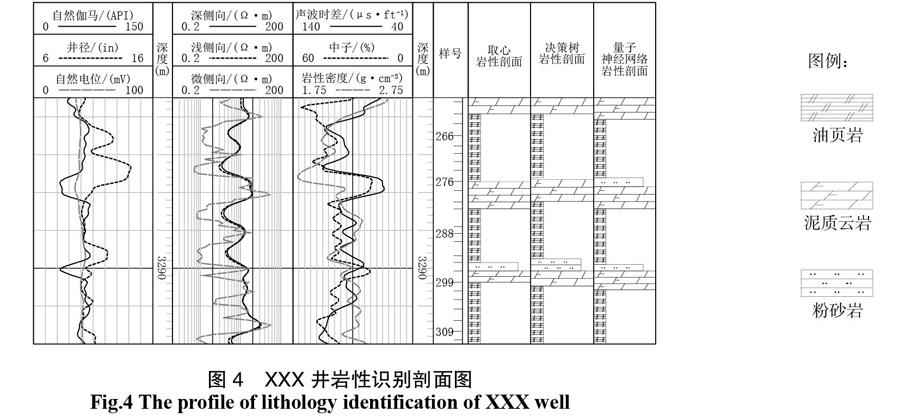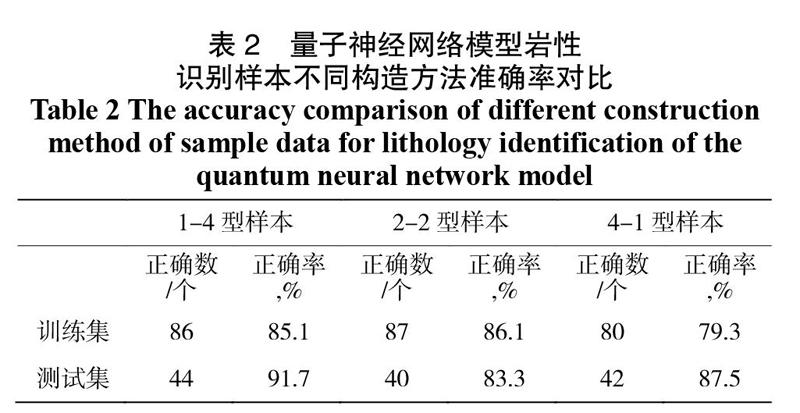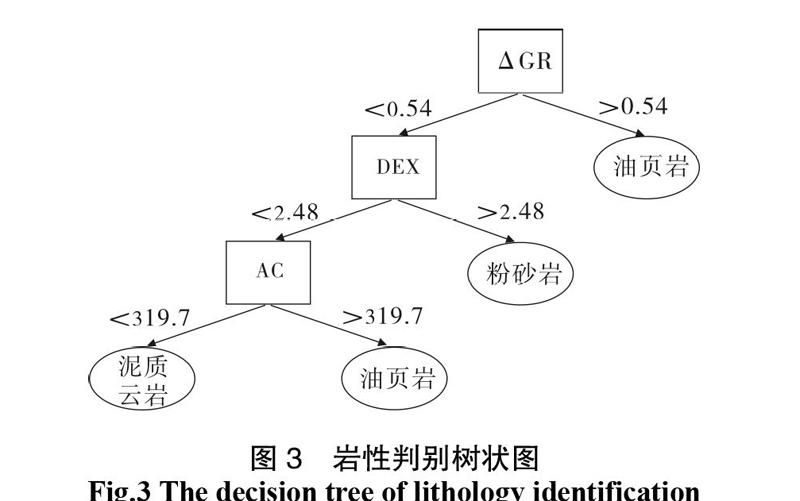D凹陷沙四段致密油储层岩性识别方法研究
2015-07-10宋延杰任一菱唐晓敏等
宋延杰 任一菱 唐晓敏 等



摘 要:首先通过统计方法对D凹陷沙四段致密油储层中的油页岩、粉砂岩和泥质云岩3类岩性测井曲线敏感性进行分析,优选出声波时差、密度和自然伽马。其次基于敏感测井响应,分别建立了测井响应交会图岩性识别方法以及决策树和量子神经网络岩性识别模型。在测井响应交会图法中,首先利用密度-标准化自然伽马交会图区分油页岩与粉砂岩和泥质云岩,然后利用密度-声波时差交会图区分粉砂岩和泥质云岩;在决策树模型中,构建了3层岩性判别树状图,直观映射出4条分类规则;在量子神经网络模型中,构建了三层前馈量子神经网络模型,并优选出精度最高的样本构造方法。通过与实际取心结果对比分析发现,决策树和量子神经网络模型均能很好地识别致密油储层复杂岩性,而测井响应交会图法难以对致密储层复杂岩性进行有效识别。
关 键 词:致密油储层;油页岩、粉砂岩和泥质云岩;岩性识别;量子神经网络;决策树;测井响应交会图
中图分类号:P 631.84 文献标识码: A 文章编号: 1671-0460(2015)10-2341-04
Research on the Method of Lithology Identification of
Tight Oil Reservoirs in S4 Formation of D Sag
SONG Yan-jie 1,2,REN Yi-ling 1,3,TANG Xiao-min 1,2,DENG Xin 1,LIU Yue 1
(1. College of Geoscience, Northeast Petroleum University, Heilongjiang Daqing 163318,China;
2. State Key Laboratory Cultivation Base of Accumulation and Development of Unconventional Oil and Gas, Jointly-constructed by Heilongjiang Province and the Ministry of Science and Technology, Heilongjiang Daqing 163318,China;
3. Exploration and Development Research Institute of Liaohe Oilfield Company, PetroChina, Liaoning Panjin 124010,China)
Abstract: The lithologies of tight oil reservoirs in S4 Formation of D Sag can be divided into oil shale, siltstone and shaly dolomite. Based on statistical methods, the sensitivity of logging curves for lithology identification was analyzed, by which interval transit time, density and gamma ray were optimized. Log response cross plot, decision tree model and quantum neural network model were established to determine the lithology with selected sensitive log responses. In the process of lithology identification by the log response cross plot, oil shale was first identified by standardized gamma ray vs. interval transit time, after that, siltstone and shaly dolomite were distinguished with density vs. interval transit time. In the process of lithology identification by decision tree model, a dendrogram with three levels was built. The model mapped four rules intuitively. In the process of lithology identification by quantum neural network model, a three-layer feedforward quantum neural network was built, and the sample construction method with the highest accuracy was screened out. By comparing with the practical coring results, both the decision tree model and the quantum neural network model can determine the lithologies in tight oil reservoirs much better than the conventional log response cross plot, and they can be applied in lithology identification of tight oil reservoirs perfectly.
Key words: Tight oil reservoirs; Oil shale, siltstone and argillaceous dolomite; Lithology identification; Quantum neural network model; Decision tree model; Log response cross plot
D凹陷沙四段致密油储层岩性复杂,测井响应变化无规律,不同岩性测井响应存在重叠。目前的岩性识别技术中,常规的取心分析识别岩性直观准确,但成本高、资料有限;岩屑录井识别岩性存在滞后性,且依赖岩屑录井资料质量。1982年wollf[1]等人提出利用测井资料自动识别岩性,自此利用计算机自动识别岩性成为了常用的岩性识别技术。
常用的测井资料岩性识别方法是应用敏感测井响应来构建交会图版[2-6]。该方法简单直观,实用性强。但是由于其只能同时利用两种测井响应,因此更适用于岩性单一且不同岩性测井响应区分明显的储层。相比之下,决策树[7-9]模型信息量大,算法稳定,能直观体现数据特点,并能自动分析各参数的权重,据此建立的非线性模型准确率高。神经网络[10-13]因其在模式识别方面有较强非线性映射能力和容错及抗干扰性能,故而在岩性识别领域应用广泛。但传统神经网络收敛速度慢,容易陷入局部极小点,且容易对训练样本过度拟合。1995年Kak[14]提出量子神经计算的概念,将神经计算与量子计算相结合。量子神经网络[15-21]有效克服了传统神经网络的缺陷,提高了神经网络模型的收敛性和准确率。
本文基于取心数据和测井数据,将该区块的岩性划分为油页岩、粉砂岩和泥质云岩三类。通过优选识别三类岩性的敏感测井曲线,分别采用测井响应交会图法、决策树模型和量子神经网络模型对该区块岩性进行识别,并且将识别结果和实际取心结果对比,给出识别该区块岩性的最佳方法。
1 致密油储层岩性识别的敏感测井响应优选
D凹陷沙四段致密油储层岩性复杂,有油页岩、含粉砂油页岩、粉砂质油页岩、粉砂岩(云质、灰质)、含灰油页岩、云质油页岩、碳酸盐质油岩、泥质云岩、含灰泥晶云岩9种主要岩性。基于各岩性地质特征及测井响应特征,将该区块的岩性统一划分为油页岩、粉砂岩和泥质云岩3类。
基于8口取心井的取心数据,分小层读取深侧向电阻率、声波时差、密度、补偿中子、自然伽马的测井响应数据,并对自然伽马曲线标准化,在此基础上进行统计分析(见表1),发现区分油页岩、粉砂岩和泥质云岩最明显的测井响应为声波时差、密度和自然伽马。除此之外,这3类岩性在补偿中子和电阻率测井响应上也有一定程度的区分。
表1 三类岩性测井响应数据统计表
Table 1 Log responses of three categories of lithology
测井响应 名称 油页岩 粉砂岩 泥质云岩
补偿中子(CNL)
,% 主要范围 40~50 20~35 30~40
平均值 44.9 29.7 31.7
声波时差(AC)
/(μs·m-1) 主要范围 350~400 250~300 280~330
平均值 380.8 267.0 295.4
密度(DEN)
/(g·cm-3) 主要范围 2.0~2.4 2.4~2.6 2.3~2.6
平均值 2.26 2.53 2.45
电阻率测井(RLLD)
/(Ω·m-1) 主要范围 5~15 3~10 5~10
平均值 11.1 10.9 9.5
标准化自然
伽马(ΔGR)
(无量纲) 主要范围 0.6~1.0 0.3~0.5 0.4~0.6
平均值 0.70 0.42 0.46
(1)深侧向电阻率测井
油页岩深侧向电阻率测井响应值较高,粉砂岩深侧向电阻率测井响应值较低,泥质云岩深侧向电阻率测井响应值中等, 介于油页岩和粉砂岩之间;
(2)孔隙度测井
油页岩具有低密度、高中子、高声波时差的测井响应特点,粉砂岩具有高密度、低中子、低声波时差的测井响应特点,泥质云岩的密度、中子、声波时差测井响应值均介于油页岩和粉砂岩之间;
(3)自然伽马测井
油页岩自然伽马测井响应值为高值,粉砂岩自然伽马测井响应值为低值,泥质云岩自然伽马测井响应值中等,介于油页岩和粉砂岩之间。
2 致密油储层岩性识别方法
2.1 测井响应交会图法识别岩性
基于敏感测井响应优选,将自然伽马、密度和声波时差作为识别岩性的主要测井响应,制作交会图版(图1、图2)。
图1 密度-标准化自然伽马交会图
Fig.1 DEN vs. ΔGR
图2 密度-声波时差交会图
Fig.2 DEN vs. AC
首先利用图1从油页岩、粉砂岩和泥质云岩中区分出油页岩。当测井响应值满足 且 时,判断岩性为油页岩,否则为粉砂岩或泥质云岩。其次利用图2区分粉砂岩和泥质云岩,当测井响应值满足 时,判断岩性为粉砂岩,否则为泥质云岩。用测井响应交会图法识别岩性的准确率为82.5%。
2.2 决策树模型识别岩性
2.2.1 决策树理论
决策树算法是常用的以实例为基础的归纳学习算法。在进行分类时,模型从根节点开始逐步对样本属性进行测试,进而判断从该节点向下的分支,每个节点代表一个属性,每个分支代表一个规则。
2.2.2 决策树岩性识别模型建立